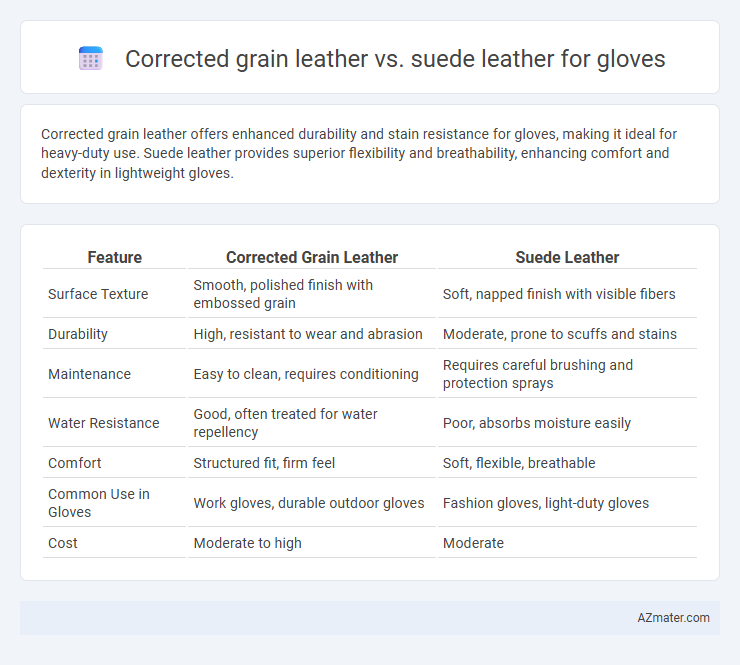Corrected grain leather offers enhanced durability and stain resistance for gloves, making it ideal for heavy-duty use. Suede leather provides superior flexibility and breathability, enhancing comfort and dexterity in lightweight gloves.
Table of Comparison
| Feature | Corrected Grain Leather | Suede Leather |
|---|---|---|
| Surface Texture | Smooth, polished finish with embossed grain | Soft, napped finish with visible fibers |
| Durability | High, resistant to wear and abrasion | Moderate, prone to scuffs and stains |
| Maintenance | Easy to clean, requires conditioning | Requires careful brushing and protection sprays |
| Water Resistance | Good, often treated for water repellency | Poor, absorbs moisture easily |
| Comfort | Structured fit, firm feel | Soft, flexible, breathable |
| Common Use in Gloves | Work gloves, durable outdoor gloves | Fashion gloves, light-duty gloves |
| Cost | Moderate to high | Moderate |
Understanding Corrected Grain Leather
Corrected grain leather is made by sanding and buffing the surface to remove imperfections, then applying an artificial grain layer, making it more durable and resistant to stains than suede leather. Suede leather, derived from the underside of the hide, offers a softer texture but is less durable and more prone to wear, making it less suitable for heavy-duty gloves. Understanding corrected grain leather highlights its enhanced protection and longevity, ideal for gloves requiring a balance of strength and aesthetic appeal.
What Is Suede Leather?
Suede leather is a type of leather with a napped finish, created by sanding the inner surface of animal hides, resulting in a soft, velvety texture ideal for gloves that require flexibility and comfort. Unlike corrected grain leather, which undergoes extensive surface treatment to remove imperfections and enhance durability, suede offers a more porous and breathable option but is less resistant to stains and wear. Suede gloves are favored for their tactile softness and style, making them suitable for casual or light-duty use where a refined appearance is desired.
Key Differences Between Corrected Grain and Suede Leather Gloves
Corrected grain leather gloves feature a smooth, polished surface achieved through sanding and coating, providing enhanced durability and resistance to stains and abrasions. Suede leather gloves have a soft, napped finish derived from the underside of the hide, offering superior flexibility and breathability but less water resistance. The key differences lie in their texture, durability, and maintenance, with corrected grain gloves being more rugged and easy to clean, while suede gloves deliver comfort and a luxurious feel.
Durability: Corrected Grain vs Suede Leather Gloves
Corrected grain leather gloves offer superior durability due to their processed surface, which resists abrasion and moisture better than suede leather gloves. Suede leather gloves, while softer and more flexible, tend to wear out faster and are prone to staining and damage from exposure to elements. For heavy-duty use or prolonged wear, corrected grain leather gloves provide enhanced longevity and protection.
Comfort and Flexibility Comparison
Corrected grain leather offers greater durability and resistance to abrasion, but suede leather provides superior softness and breathability, enhancing overall comfort in gloves. Suede's textured surface allows for increased flexibility and better hand movement, making it ideal for tasks requiring precision. While corrected grain leather gloves offer robust protection, suede gloves excel in delivering a more comfortable and flexible fit for extended wear.
Aesthetics and Texture: Which Glove Looks Better?
Corrected grain leather gloves feature a smooth, polished surface with consistent texture due to buffing and finishing processes, offering a sleek and refined look ideal for formal wear. Suede leather gloves showcase a soft, napped finish with a matte appearance, providing a luxurious, tactile feel that emphasizes comfort and casual elegance. The choice between corrected grain and suede leather gloves depends on desired aesthetics: corrected grain presents a crisp, uniform look, while suede delivers a plush, nuanced texture that ages with character.
Maintenance and Care for Each Leather Type
Corrected grain leather gloves require regular cleaning with a damp cloth and conditioning with leather-specific products to maintain suppleness and prevent cracking, as their surface is treated to enhance durability. Suede leather gloves demand specialized care including gentle brushing with a suede brush to remove dirt and avoiding water exposure to prevent staining and texture damage. Both types benefit from proper storage in a cool, dry place away from direct sunlight to preserve their appearance and longevity.
Cost Considerations: Price Differences Explained
Corrected grain leather gloves generally cost more than suede leather gloves due to the extensive processing required to remove imperfections and apply surface coatings, enhancing durability and uniform appearance. Suede leather, derived from the underside of the hide, involves less processing, resulting in a softer texture but lower price point. Budget-conscious buyers often choose suede gloves for affordability, while corrected grain leather is preferred for long-term investment despite the higher initial cost.
Best Applications for Corrected Grain and Suede Leather Gloves
Corrected grain leather gloves offer durability and resistance to wear, making them ideal for heavy-duty applications such as construction, gardening, and industrial work. Suede leather gloves provide superior flexibility, breathability, and a soft touch, best suited for light-duty tasks like driving, delicate handling, and fashion accessories. Choosing between corrected grain and suede leather gloves depends on whether durability or comfort and dexterity are the primary requirements.
Which Leather Glove Should You Choose?
Corrected grain leather gloves offer enhanced durability and water resistance due to their surface coating, making them ideal for heavy-duty tasks and outdoor use. Suede leather gloves provide superior flexibility and breathability, preferred for precision work and comfort during lighter activities. Choosing between these gloves depends on whether you prioritize rugged protection or tactile sensitivity in your tasks.

Infographic: Corrected grain leather vs Suede leather for Glove
 azmater.com
azmater.com